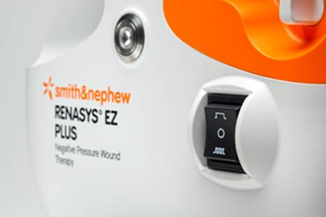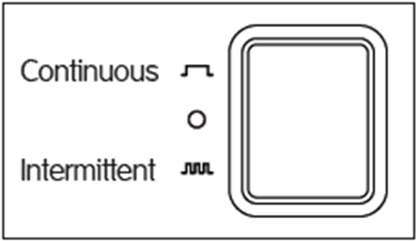- Ensure the device needs is switched off.
- Press the following buttons on the device in this order;

- The first option will be continuous and then intermittent - use arrows to scroll down to select required therapy mode.
- Press button to select required therapy mode.
No, the battery in RENASYS GO is a lithium battery which means that it can be charged at anytime.
The battery will last on average 20 hours.
- Newly delivered devices will prompt language selection.
- Language can also be changed manually at any time by a 3 button press from the OFF state
- Press the following buttons on the device in this order;

- Scroll down to your chosen language and press
 to select
to select
The bag and straps are single patient use. The bag itself can be wiped down with standard cleaning agents between dressing changes. Bags and straps should not be shared between patients.
Testing has not been carried out on the RENASYS GO device so Smith & Nephew cannot advise that the device is used when flying. As a result the device should be turned off and conventional dressings used during the flight.
Smith & Nephew provide guidelines for cleaning and disinfecting RENASYS devices, these guidelines should be followed in-line with local Infection Control Trust Policy.
A copy of the cleaning and disinfecting guidelines is available from Smith & Nephew customer care team, marketing team and your local Smith & Nephew Territory Manager or Clinical Specialist. You can view a copy by clicking
here.
Before a device is returned clinicians must perform a clean of the device. Local Infection Control policy must be followed and Smith & Nephew provide guidelines for cleaning and disinfecting devices which you can view by clicking
here.
1.1kg
Please contact our Customer Care Department. The Customer Care Advisors will ask for the following information: device serial number, date of activation and date of deactivation. If collection of the pump is requested you will need to provide a contact name, collection address and telephone number.
UK
T: 0845 250 1031 (Monday - Friday 8.30am-5pm)
F: 08704 201 496
Email:
npwtorders.uk@smith-nephew.com
Republic of Ireland
T: 01 276 9700 (Mon-Fri 9am - 5.30pm)
F: 01 276 4970
E:
orders@oxygen-care.ie
Northern Ireland
T: 028 90665539 (Mon-Fri 9am - 5.30pm)
F: 028 90666379
E:
orders@oxygen-care.ie
RENASYS GO and EZ PLUS is contra indicated in the presence of:
- Necrotic tissue with eschar
- Untreated osteomyelitis
- Malignancy in wound (with exception of palliative care to enhance quality of life)
- Exposed arteries, veins, organs or nerves
- Non-enteric and unexplored fistulas
- Anastomotic sites
The RENASYS GO device is a single lumen device. If the dressing is firm, dry and compressed, this indicates the machine is suctioning properly and there is no blockage at the dressing end. As wounds heal they produce less exudate. As the exudate level builds up in the wound, exudate currently in the tubing will be pushed into the canister.
You can shower but not bath To shower you must disconnect the device first.
- The RENASYS GO should be placed on pause by pressing the Select button once or the machine turned off by pressing the keylock button then the power button.
- The dressing tubing should be clamped, disconnected from the canister tubing and the tubing caps applied to both ends. The RENASYS GO is now disconnected from the dressing and dressing tubing.
- The dressing should remain in situ and a shower can be taken.
- Once you are dry, the caps can be undone from both ends of the tubing and the tubing can be re-connected.
- The clamp should then be undone from the dressing tubing and the RENASYS GO device restarted.
DO NOT TAKE THE RENASYS GO DEVICE INTO THE SHOWER.
3.3kg
40 hour battery life
Power switch selects between off/on and continuous or intermittent suction.

Intermittent therapy mode = 5 minutes ON/2 minutes OFF.

The settings for RENASYS GO & EZ PLUS are 40mmHg - 120mmHg. RENASYS GO devices are sent out from Smith & Nephew set at -80mmHg and any pressure above -50mmHg is considered efficacious however the management of the exudate needs to be considered and pressures between -80mmHg and -120mmHg are deemed appropriate for this.
Our guidelines on therapy settings are general recommendations. You may wish to vary the pressure settings to optimise NPWT therapy based on individual patient need and the lead clinician's guidance.
Negative pressure may be increased where:
- High levels of exudate/excessive drainage
- Large wound volume/size
- There is a tenuous seal/positional difficulties maintaining the seal
High pressure may cause tissue necrosis and increase pain for patients. Careful consideration and consultation with the lead clinician should be sought prior to exceeding -120 mmHg.
Negative pressure may be decreased where:
- Pain or discomfort is not relieved by appropriate analgesia
- The patient is elderly and/or nutritionally compromised
- There is a risk of excessive bleeding (for example, patients on anticoagulation therapy)
- The circulation is compromised (for example, peripheral arterial disease)
- There is excessive granulation tissue growth
- With pressures lower than -40mmHg consider discontinuing therapy
The table below shows some suggested pressures for different wounds types:
WOUND TYPE |
Suggested Filler |
Pressure Setting |
Acute/Traumatic |
Gauze or Foam |
-80 to - 120mmHg |
Cardiothoracic (partial thickness) |
Foam |
-80 to - 120mmHg |
Partial Thickness Abdominal muscle intact) |
Gauze or Foam |
-80 to - 120mmHg |
Pressure Ulcers |
Gauze |
-60 to -80mmHg |
Diabetic foot ulcers post-surgery |
Gauze |
-60 to -80mmHg |
Diabetic foot ulcers |
Gauze or Foam |
-60 to -80mmHg |
Meshed grafts/bioengineered tissue |
Gauze |
-50 to - 80mmHg |
Flaps |
Gauze |
-50 to-80mmHg |
Dehisced surgical wounds |
Foam |
-80 to - 120mmHg |
Chronic wounds |
Gauze |
-80mmHg |
Enteric fistula (inclusion of fistula in the dressing) |
Gauze |
-80mmHg |
Enteric fistula (isolation of fistula) |
Gauze or Foam |
-80mmHg |